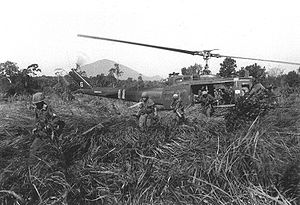Operation Attleboro
This article includes a list of general references, but it lacks sufficient corresponding inline citations. (January 2013) |
| Operation Attleboro | |||||||
|---|---|---|---|---|---|---|---|
| Part of the Vietnam War | |||||||
 Infantrymen attacking out of a UH-1D helicopter during Operation Attleboro. | |||||||
| |||||||
| Belligerents | |||||||
|
|
| ||||||
| Commanders and leaders | |||||||
|
William E. DePuy | Unknown | ||||||
| Units involved | |||||||
|
1st Infantry Division 4th Infantry Division 27th Infantry Regiment |
| ||||||
| Casualties and losses | |||||||
| 155 killed and 494 wounded |
US report: 2,130 killed 44 POW | ||||||
Operation Attleboro was a Vietnam War search and destroy operation by the 196th Light Infantry Brigade. The operation was named after Attleboro, Massachusetts, where the brigade had been formed. Operation Attleboro turned out to be the largest series of air mobile operations to that time, involving all or elements of the 196th Light Infantry Brigade, 25th Division, 1st Infantry Division, and a brigade of the 4th Division, as well as numerous Army of the Republic of Vietnam and Regional Forces/Popular Forces and Nungs. In the end, the operation became a corps operation commanded by II Field Forces.
Operation
The operation was divided into two phases. While the initial fighting was light, in late October US forces, consisting of the 196th Light Infantry Brigade and the 1st Battalion, 27th Infantry Regiment (25th Infantry Division), encountered the 9th Viet Cong Division, resulting in a major three-day battle. Fighting was then taken over by the 1st Infantry Division.
The most significant fighting occurred when Viet Cong forces assaulted the US perimeter at Suoi Da on November 8. The assault was defeated by artillery and air strikes. Afterwards, a large Viet Cong base camp was detected. It was one of the largest hauls to date in the war, with the American forces seizing two million pounds of rice; 116 transportation bicycles; approximately 25,000 Chinese-made hand grenades (many containing tear gas); 481 M18 Claymore anti-personnel mines; 80 rocket launchers; 25 machine guns; myriad number of pistols; rifles like AKMs and AK-47s; clothing; tobacco; miscellaneous foods like cooking oil, salt and fish; and bountiful gallons of petroleum.
Aftermath
US intelligence later estimated VC/PAVN losses during Operation Attleboro as 2,130 killed, 900 wounded, and over 200 missing or captured. Allied losses totaled 155 killed and 494 wounded.[1]
US military spokesmen claimed that the most significant result of Operation Attleboro was the severe blow struck against the communists' supply system. In fact, however, the operation failed to eradicate the Viet Cong's political domination in Tay Ninh Province, as they quietly returned to the area from their sanctuaries in Cambodia just after the American withdrawal.[2]
Notes
- ^ Tucker 2011, p. 81.
- ^ Daddis 2011, p. 7.
References
- Summers, Harry G. Historical Atlas of the Vietnam War. New York: Houghton Mifflin Company.
{{cite book}}: Cite has empty unknown parameter:|coauthors=(help) - "Attleboro battered Reds' supply system". Stars and Stripes. 1966-11-28. Retrieved 2007-07-11.
- "The Giant Spoiler". TIME Magazine. 1966-11-18. Retrieved 2007-07-11.
- Tucker, Spencer C. (2011). The Encyclopedia of the Vietnam War: A Political, Social, and Military History (2nd ed.). Santa Barbara, California: ABC-CLIO. ISBN 9781851099603.
{{cite book}}: Invalid|ref=harv(help) - Daddis, Gregory A. (2011). No Sure Victory: Measuring U.S. Army Effectiveness and Progress in the Vietnam War. New York: Oxford University Press. ISBN 9780199746873.
{{cite book}}: Invalid|ref=harv(help) - "Disappearing Act". TIME Magazine. 1966-11-25. Retrieved 2007-07-11.
- "Encouraging Returns". TIME Magazine. 1966-12-09. Retrieved 2007-07-11.
